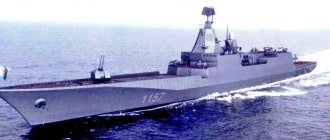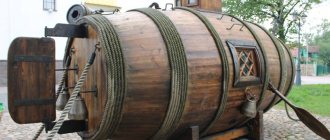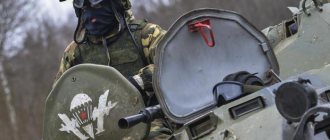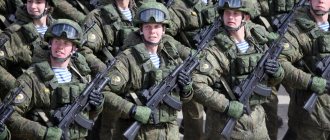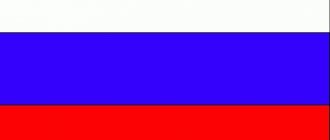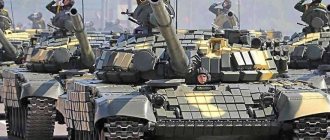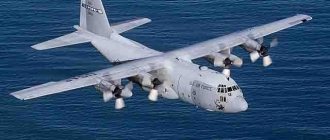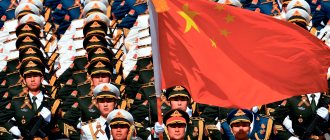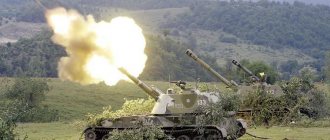By the end of 2022, Russian strategic nuclear forces will be 85% equipped with modern weapons. This was announced while speaking in the Federation Council, acting. Chief of the Main Operations Directorate of the General Staff of the RF Armed Forces, Lieutenant General Viktor Poznikhir. Izvestia studied the state of the country's nuclear shield.
Repeating "Yars": what kind of missiles Russia is building
Over six years, the military received more than 200 strategic carriers
Optimal triad composition
Each state has traditional components of the triad. This:
- Ground-based types of strategic weapons.
- Naval weapons.
- Air weapons.
The main components of such a system could be strategic aviation, nuclear-armed submarines, and ballistic missiles. The nuclear triad includes various types of nuclear weapons operating in air, sea or land space.
Due to the peculiarities of the nuclear strategic forces of the Russian Federation, the country is one of the most powerful militarily among the states of the world. Besides it, only the United States has a nuclear triad.
Defense against nuclear weapons
Work in the military sphere, the purpose of which was to develop methods for using nuclear elements, also gave impetus to the development of systems capable of responding to the launch of weapons of mass destruction, as well as neutralizing them.
Radar stations are used to detect nuclear weapons and record the coordinates of their use, calculate the time of arrival of the deadly cargo, the flight path and other parameters. In case of danger, they will immediately transmit a signal to launch a missile attack. Space stations perform the same functions.
To destroy or neutralize nuclear carriers, there are missile and space defense troops, as well as missile defense forces. In some cases, this also includes air defense troops, whose tasks include the destruction of airborne delivery vehicles for nuclear devices.
One of the most promising strategic directions at present is Russian nuclear weapons. Photos of him are given in the article.
Characteristics of the Russian triad
According to current data, Russia’s nuclear triad includes:
- Strategic naval forces.
- Strategic Missile Forces of the Russian Federation.
- Strategic aviation weapons.
It is important to note that such a triad never includes a country’s tactical nuclear warheads.
The peculiarity of the structure of the nuclear triad of the Russian Federation is that all the nuclear warheads the country has are divided between the main types of its troops that have a strategic purpose. This ensures that in the event of unforeseen circumstances, the existing weapons will not be completely destroyed - they are not collected in one place. Thus, Russian multipurpose nuclear submarines never collect everything in one place. Additionally, this is a guarantee of proper flexibility in the use of nuclear weapons, based on the need for their practical use.
That is, if, due to a surprise attack by the enemy, one or even two basic components of the triad are destroyed, the possibility of a retaliatory strike remains.
History of the creation of nuclear weapons
The very first work related to the physics of the atomic nucleus began in the 20s (in the Soviet Union). In the 30s, a noticeably larger number of research institutes were already working in this area. The year 1940 was marked by the phenomenon of nuclear fission. After this event, the USSR Academy of Sciences created a special commission that worked on the problem of uranium. Her tasks included full coordination of ongoing research regarding the study of the principle of fission of atomic nuclei. In addition, the commission also had to look for new methods for separating uranium isotopes.
It is worth noting that already at that time the principle of a nuclear chain reaction was considered in the light of military applications, but work in this area was, for the most part, an ordinary research program. The end of the Great Patriotic War was the temporary boundary that put an end to approximately 75% of research in the field of nuclear physics.
Land component
Russian intercontinental ballistic missiles, deployed in mobile or stationary versions, form the basis of the land component of the nuclear triad. They are characterized by:
- high degree of security for stationary structures, that is, launchers located deep in mines;
- dispersion in the area;
- quick change of positioning in the case of mobile installations;
- resistance to nuclear explosions of medium strength.
That is, they are extremely difficult to disable, due to the difficulty of detection and high-quality security.
Marine component
Russian multi-purpose nuclear submarines act as the main carrier of ballistic intercontinental missiles on water. This technique has excellent covert maneuvering capabilities and is also characterized by high autonomy. Movements are limited only by the vastness of the World Ocean.
Missile launches can be carried out from any point when the boat itself is underwater.
Some types of surface ships can be equipped with nuclear-armed cruise missiles. It also strengthens the protection of the state.
Armament of the naval component of the Russian triad
The composition of Russia's nuclear triad is constantly being supplemented, updated, and improved. Test runs are being carried out. Thus, the components of the nuclear triad were recently tested - a launch was carried out from the Vladimir Monomakh vessel, which is an SSBN submarine missile cruiser. All tests passed normally. The launch was carried out underwater.
The Russian Navy will soon receive a new, third cruiser, which is part of the Borei project. In accordance with the existing plan, by 2022 it will be replenished with eight SSBN-class vessels, each of which will carry 16-20 full-fledged ballistic missiles capable of hitting a target at a distance of up to 9 thousand kilometers from the launch site.
On the relevance of nuclear weapons
Currently, nuclear weapons of the United States and Russia are constantly compared by experts. This is happening due to growing tension between the two countries, which dates back to the time of the conflict in Ossetia. Events in Ukraine became a new round of tension in bilateral relations between the Russian Federation and the United States, which caused an intensification of the arms race. Although the development has been going on for several years, a completely current example of the arms race can be called the T-14 tank on the Armata platform.
Although tensions between the EU countries, the USA and the Russian Federation are escalating every month, the options for Russia to use nuclear weapons are considered only as retaliatory steps taken in case of a violation (or attempted violation) of the country’s territorial integrity.
Air component
The strategic aviation of the Russian Federation is capable of carrying nuclear bombs along with air-borne cruise missiles with nuclear warheads. Modern strategic bombers are designed for long flights when patrolling airspace. They can deal a serious blow to the enemy when hostilities begin.
Due to the capabilities of modern technology, the country has the ability to attack almost any corner of the world. This has been confirmed repeatedly during tests of the nuclear triad under a variety of conditions.
In stock
It is always difficult to get down to numbers in this area, since the Russian military does not spoil the public with too much publicity. However, relying on well-known open sources and Western research, we can estimate something.
At the moment, the Strategic Missile Forces group includes four types of missiles: R-36M2 (no more than 40–50 in the Dombarovsky and Uzhur position areas), “Topol” (about 50–60), “Topol-M” (18 mobile in Teykovo and 60 mine-based in Tatishchevo) and “Yars” (almost all available mobile divisions, as well as in the Kozel mines). “Yarsov”, as Shoigu told us, 109 units have been delivered since 2012, but Shoigu became the Minister of Defense in 2012, and the missiles began to arrive earlier - since the end of 2009. Thus, the latest collection of The Military Balance, based on data from about a year ago, claims that in total Russia at that time had 117 deployed missiles of this type: 103 mobile and 14 silo-based. Now there are probably more than 120 of them.
yars
Submarine of project 667BDRM "Dolphin" of the Northern Fleet of the Russian Navy at the pier in Gadzhievo, Murmansk region
Photo: RIA Novosti/Ramil Sitdikov
It is also customary to include the 30 UR-100N UTTH silo missiles remaining from the USSR into the Strategic Missile Forces grouping, however, according to Western experts, they have already been withdrawn from combat duty.
The naval group of strategic nuclear forces includes six Project 667BDRM "Dolphin" boats with 96 "Sineva" and "Liner" SLBMs, as well as three Project 955 "Borey" boats with 48 "Bulava" SLBMs. The fleet still has one boat of Project 667BDR “Kalmar” with 16 R-29RKU-02 (“Station-2”) missiles.
Drones will protect Yars and Topols
UAVs equipped with electronic reconnaissance systems will become the all-seeing eye of strategic missile systems
As of September 2022, the aggregated data transmitted by Russia to the United States under the New START Treaty looked like this: 517 deployed ICBMs, SLBMs and heavy bombers with 1,420 warheads. It is not difficult to see that Russia is underloading its missiles: if you count all available carriers at maximum load in blocks, you will get at least 1.6 thousand seats on missiles alone (possibly more, depending on the ratio of Sineva and Liners in the ammunition load project 667BDRM). This is completely normal, moreover, if control regimes are maintained, this practice will continue. The Americans practice this to an even greater extent: their Tridents, designed for 12-14 small blocks or 8 medium ones, now carry an average of 4-5 warheads, and the Minutemen have been converted to monoblock equipment, although their standard breeding platform can accommodate three warheads .
Armament of the air component of the Russian triad
Today, the air component of Russia's nuclear triad is represented by the Strategic Missile Forces, armed with about eight dozen Topol mobile systems of various modifications, along with six dozen Topol-M installations stationary in silos.
Missiles from the ICBM category represent a light class of these weapons. They are characterized by successfully overcoming serious enemy solid waste using various techniques, along with high mobility.
On average, Topol operates at a distance of 11 thousand kilometers. Additional power of air weapons is provided by the location of components of the strategic missile forces of the Russian Federation and the SpN, S-300, Pantsir-S1, Tor-M1V installations.
There are also ballistic intercontinental missiles on combat duty in Russia, which are located in special launch silos that have effective protection against a nuclear explosion. This includes RS-18B and RS-20B missiles - a total of about 130 launch vehicles with two dozen warheads. These are the most powerful missile systems with an impressive take-off weight.
Modern missile defense systems are not ready to cope with this type of missiles, especially if they are used not individually, but in combination with other weapons.
Keys to Hell - the saga of how the Motherland’s nuclear shield was created
Photo: Social networks On July 16, 1945, the world's first atomic bomb exploded in Alamogordo, a desert area of the American state of New Mexico. So far this was only a test explosion, the success of which was then known only to a limited circle of people in the USA, England and the USSR - thanks to foreign intelligence. Two days before the start of the Soviet Army's offensive in Manchuria, on the orders of US President Truman and without consultation with the Soviet Union, an atomic bomb was dropped on Hiroshima on August 6, 1945, and on Nagasaki on August 8. Thus, America publicly demonstrated to the whole world that it had acquired a nuclear monopoly. And almost immediately, both diplomatic and public atomic blackmail of the USSR began.
The Second World War was coming to an end, and the American Department of Defense was already thinking about developing plans for a war against the USSR, the main ally of the United States in the anti-Hitler coalition. In November 1945, the US War Department designated 20 Soviet cities as targets for atomic bombing.
As the number of nuclear bombs in the US arsenal grew, so did the number of Soviet cities that Hiroshima and Nagasaki were waiting to take into account. In 1948, the Charpotir plan was approved, which envisaged striking 70 Soviet cities with 200 bombs. In 1949, the “Dropshot” plan involved the use of 300 atomic bombs. In 1950, the Trojan plan arose, according to which it was planned to destroy 100 Soviet cities using 300 atomic bombs.
Support the publication
- Join the CLAN
Or
Here is just one of hundreds of examples. In 1947, University of Texas professor R. Montgomery wrote: “Within 24 hours we can destroy 75 million Russians without losing a hundred people. If we need to destroy the Russians, then let’s do it now, let’s not wait three years.”
US Secretary of War Henry Stimson did not hesitate to say that America could now negotiate with Russia by “defiantly shaking” the atomic bomb. In American world politics, the era of “nuclear diplomacy” began, which in relation to the USSR meant one thing - atomic blackmail.
NUCLEAR PROBLEM
The issue of eliminating the US nuclear monopoly and creating its own nuclear weapons became a matter of life and death for the USSR - literally.
The Soviet leadership knew that atomic work was underway in England and the United States at least since the fall of 1941, but there was no time then. But already on September 28, 1942, State Defense Order No. 2352ss “On the organization of work on uranium” appeared.
In 1942, technical lieutenant Georgy Flerov, finding himself in Voronezh, rushed to the university library. He did not find a single report on research into uranium fission in American and English scientific journals. But before, publications on this topic were published in publications from issue to issue. Flerov, a future academician, wrote to the chairman of the State Defense Committee, I.V. Stalin. Somehow, strangely enough, the lieutenant’s letter was not lost in the Kremlin mail and reached the addressee.
“At the end of the summer of 1942, the Central Committee of the CPSU and the government received a proposal about the need to resume research in nuclear physics and radiochemistry interrupted by the war,” M.G. Pervukhin, deputy chairman of the Council of People’s Commissars and People’s Commissar of the chemical industry during the war, later recalled. – Scientists were worried about whether Nazi Germany would overtake us. At the beginning of 1943, the State Defense Committee instructed me to plan, together with I.V. Kurchatov and other scientists, an event to organize research designed to solve the issues of using intra-atomic energy for military purposes.”
A network of legal and illegal residencies was created in Great Britain and the USA. In September 1941, NKGB resident in London Anatoly Gorsky received a detailed report from the British Uranium Committee to Prime Minister Winston Churchill, which described the design of an atomic bomb, the principles of initiating a nuclear explosion, calculations of the critical mass of uranium - 235 and the diffusion method of its production.
On August 20, 1945, GKO (State Defense Committee) Resolution No. 9887 ss/op “On the Special Committee under the GKO” was adopted. This Resolution created a special committee with emergency powers to solve any problems of the Uranium Project. Its members included: L.P. Beria – chairman; G.M. Malenkov - Secretary of the CPSU Central Committee; ON THE. Voznesensky - Chairman of the State Planning Committee of the USSR; B.L. Vannikov - People's Commissar of Ammunition; A.P. Zevenyagin – Deputy People's Commissar of Internal Affairs; I.V. Kurchatov – Head of Laboratory No. 2 of the USSR Academy of Sciences; academician scientific supervisor of the problem; P.L. Kapitsa – academician, director of the Institute of Physical Problems of the USSR Academy of Sciences, M.A. Mikheev – Secretary of the Special Committee; M.G. Pervukhin - People's Commissar of the Chemical Industry of the USSR.
By the end of 1945, over 50 research organizations were involved in work on the Atomic Problem, and by the end of 1946, about 100 research institutes and laboratories. From 1946 to 1951, special faculties of universities were able to train over 2,700 specialists, including 1,500 physicists of various specialties. Special laboratories were created, design bureaus were formed and secret atomic cities were built.
A FEAT OF INTELLIGENCE AND SCIENCE
In 1945–1949, few people in the USSR knew that Academician Kurchatov and his team were able to solve the problem of creating an atomic bomb so quickly because they were helped by Soviet intelligence officers who managed to obtain the main atomic secrets of England and the United States. Who are they, these atomic intelligence officers? This is Arthur Adams, who, while working in the United States, recruited physicist Martin Camp (surname changed), who gave Adams about five thousand sheets of secret data on the American atomic project and 18 samples of pure uranium, beryllium, heavy water and other materials. Only in 1999, A.A. Adams was awarded the title of Hero of the Soviet Union (posthumously).
Alexander Semenovich Feklisov worked in New York from 1942 to 1946. He maintained operational contact with Klaus Fuchs, from whom important information was received, including on the design of a hydrogen bomb. In 1996, Feklisov was awarded the title of Hero of Russia. The size of the article does not allow us to name many other patriots of the country who, risking their lives outside the USSR, ensured the security of the country.
Academician Yu.B. Khariton, three times hero of Socialist Labor, Laureate of the Lenin State Prize, wrote in January 1993: “In those dramatic circumstances, the feat of Soviet intelligence played an exceptional role. He contributed to the guaranteed success of the first Soviet atomic explosion, as he contributed to the emergence of the foundations of the nuclear industry.”
Undoubtedly, atomic and thermonuclear weapons were created in the Soviet Union, primarily due to the presence of powerful scientific, technical, and intellectual potential. A large group of Soviet scientists made a decisive contribution.
At the Semipalatinsk testing site (“Training Site No. 2”), a 37-meter steel truss tower was built, on which “Product No. 1” was later raised. The bomb's yield was 22 kilotons.
At 06.33 on August 29, 1949, the sealed door to the equipment room was opened and the power to the automation system was turned on. 1300 instruments and 9700 indicators were ready to register all explosion phenomena. The experience manager periodically announced the time remaining before the explosion via the broadcast warning system.
20 seconds before the explosion, the operator, at the command of the head of the explosion, turned on the main switch connecting the “product” to the automation system, and at exactly 7.00 the entire area was illuminated with a blinding light. Approximately 30 seconds later, a shock wave approached the command post. It became clear that the experiment was a success. Everyone rushed to each other, hugged, shouted: “We have her!” We managed to do it!”
THE WEST'S REACTION
On September 28, 1949, English Labor Party MP Blackburn lamented in an interview with the Daily Express: “Western experts believed that the Soviet Union would not be able to produce the first atomic bomb until 1953. Now it turned out that the Soviet Union was technically ahead of us...” A political observer for the Italian magazine Tempo wrote: “Russia gave stunning proof of its will, its ability to work and its ability to keep a secret... Their scientific efforts were colossal, their organizational work was colossal, titanic Stalin's will prevailed."
As for America, it experienced a huge shock. Member of the House of Representatives Rankine proposed moving the US capital from Washington to the small town of Paducah in Kentucky. Senator Wiley sent a letter to US Secretary of Defense Jackson, where he insisted on the transfer of US Department of Defense departments from the Pentagon building and their dispersal throughout the country.
Yes, this nuclear explosion cooled the heads of many. Its power could be judged at least by the size of the “funnel”, where a huge lake formed over the years. One of the authors had a chance to visit the shores of this lake. The remains of the 37-meter tower still remain. After the successful testing of the first atomic bomb, Stalin once said in a small circle that if we had been a year and a half late with our bomb, we would probably have “tried” it on ourselves.
After all, by this time the American generals had already developed a plan for an atomic attack on the USSR. As a result of the implementation of this plan, the fate of Hiroshima and Nagasaki was to befall the main Soviet administrative, cultural, economic and military centers.
GATE TO HELL
Thus, on August 29, 1949, after the successful testing of the first Soviet atomic device at the Semipalatinsk test site, the keys to hell, which were monopolized by the Americans, ended up not only in the US capital, but also in the Moscow Kremlin. When this happened, no one dared to open the doors to hell.
This situation was further strengthened in connection with the creation of thermonuclear weapons in the Soviet Union. The Soviet thermonuclear explosion took place on August 12, 1953. Academician Yu.B. Khariton believes that this explosion “had an undeniable priority: it was the world’s first explosion of a transportable bomb ready for use. The United States had nothing like this at that point in time.”
The Soviet hydrogen bomb was created by: A. Sakharov, Y. Zeldovich and Yu. Trutnev. The Americans carried out their first thermonuclear explosion in 1952, but their device was heavy - about 60 tons... They tested a real thermonuclear bomb on the surface of the Pacific Bikini Atoll only in 1954.
The Semipalatinsk test site, due to its location, had limited capabilities for testing powerful thermonuclear explosions. And the lack of maritime conditions made it impossible to carry out underwater and surface nuclear explosions, while the main rivals of the Soviet Union in the nuclear confrontation had such conditions and actively used them. Nuclear explosions in sea conditions, in terms of the totality of their parameters and damaging factors, differ significantly from those above ground, so it was necessary to create a new test site.
On July 31, 1954, two government resolutions concerning nuclear weapons were signed: on the organization of NII-1011 (today the Russian Federal Nuclear Center) and the formation of a new test site.
NEW EARTH
According to unconfirmed information, the discovery of the Novaya Zemlya archipelago by Russian Pomors dates back to the 11th century. No one has been able to convincingly prove this, but the original name of the archipelago - Matka - is of purely ancient Russian origin. Historical documents of the 15th-16th centuries already indicate that Pomeranian industrialists involved in hunting visited these islands. In 1652, by decree of Tsar Alexei Mikhailovich, the first expedition was sent to the archipelago to search for silver ores. The first Russian explorer of Novaya Zemlya was Fyodor Rozmyslov, who in 1768 conducted a survey of the Matochkin Shar Strait. In 1870, to suppress the claims of foreign states to this territory, a squadron was sent under the command of Vice Admiral Posyet, consisting of two ships - the corvette Varyag and the clipper Zhemchug.
The first settlers, Nenets Foma Vylka and his family, lived permanently on the archipelago since 1869. And in 1877, construction began on a rescue station and the settlement of several Nenets families resettled to Novaya Zemlya in the settlement of Malye Karmakuly.
The sovereignty of Soviet Russia over the islands was secured in 1923 by a resolution of the Council of Labor and Defense on the opening of radio stations in the eastern part of the Matochkin Shar Strait and on Cape Zhelaniye near the northern tip of the archipelago. And in 1924, a decision was made to create an island Council of Deputies, the chairman of which, like the fishing artel, was Tyko Vylka, the son of the first Nenets settler. By the way, he left his mark on history. During the Great Patriotic War, a fascist plane attacked the settlement of Belushya Guba, the administrative center of Novaya Zemlya. Several residents were injured. Vylka turned to the military, asked for armor-piercing cartridges, received them and for three days retired into the tundra to Cape Morozov to wait for the enemy. The enemy has arrived. And there was only one shot. For this feat Tyko Vylka was awarded a military order.
In 1954, 104 families already lived in the village of Belushya Guba. When it became the center of the Novaya Zemlya test site, the Nenets left Novaya Zemlya. And until the early 1990s, the very existence of settlements on Novaya Zemlya was a state secret.
When choosing a location for the test site, the reconnaissance commission of the Navy and a commission consisting of specialists from the Ministry of Defense, the Academy of Sciences and the Ministry of Medium Engineering took into account factors such as the location of the test sites at the maximum distance (300-500 km) from populated areas and routes of the Northern Sea Route, the ability to conduct tests in various environments, the ability to study the impact of an underwater nuclear explosion on ships, submarines, and naval facilities in real conditions, the ability to record physical processes and parameters of a thermonuclear explosion, the ability to equip an airfield for transport aviation.
As a result, the Novaya Zemlya archipelago was chosen for the location of the test site, the village of Belushya Guba became its center, and the airfield was located in the village of Rogachevo. Local residents, about 400 people, were evicted to the Arkhangelsk region, where they were provided with housing. Hero of the Soviet Union, captain 1st rank Starikov V.G. was appointed the first head of the training ground.
In the summer of 1954, military builders landed on Novaya Zemlya. The construction of the so-called “Object-700” has begun, with an area of more than 90 thousand square kilometers. Technical buildings, living quarters, laboratories and an airfield were ready within a year.
The Novaya Zemlya nuclear weapons test site was opened on September 17, 1954, with its center in Belushaya Guba. During the Cold War, it was intended to study the damaging effects of explosions on naval facilities and develop a means and method for their protection. On September 21, 1955, the first underwater nuclear explosion in the USSR was carried out on Novaya Zemlya - in Chernaya Bay at a depth of 12 meters.
FEAT OF THE TESTERS
On October 10, 1957, the first Soviet torpedo with a nuclear warhead was successfully tested. The submarine from which the torpedo was fired was not damaged by the shock wave.
The peak of testing occurred in 1961-1962 - during the exercises “Air”, “Rosa”, “Volga”, “Rainbow”, “Coral”, “Tulip”, “LTU2” and “Shkval” 56 nuclear devices were detonated. New types of charges were tested, and the actions of military units of the Navy, Strategic Missile Forces (Strategic Missile Forces) and Ground Forces during actual nuclear explosions were checked.
In total, from September 21, 1955 to October 24, 1990, 132 nuclear explosions were carried out on Novaya Zemlya: 87 atmospheric, 3 underwater, and 42 underground. This is quite a bit compared to the Semipalatinsk statistics, where there were 468 tests. 616 nuclear and thermonuclear charges were detonated. However, the total power of all northern explosions is 94% of the power of all test explosions carried out in the Soviet Union. But at the same time, significantly less damage was caused to the surrounding nature, since the overwhelming majority of them were thermonuclear, they did not scatter heavy radioactive isotopes into the surrounding space.
The authors were lucky enough to meet with one of the veterans of the special risk unit (who served on Novaya Zemlya), retired captain of the third rank, Vladimir Mikhailovich Abramov. In the ward of the 2nd hospital for war veterans, we were met by a gray-haired, harrier-short man. His story significantly supplemented “our great knowledge” about that harsh time and events on Novaya Zemlya, which for many years were classified as “Top Secret”.
The work of testers has never been easy or safe,” says Vladimir Mikhailovich. Accidents also happened. The biggest accident happened at the test site on October 14, 1969. An hour after the next underground explosion, a stream of radioactive gas and steam escaped through a fault in the ground to the surface. The level of gamma radiation jumped to several hundred roentgens/hour. For the next hour, most of the personnel servicing the test were below him. There was no emergency plan. 344 people were affected by high levels of radiation.
Two nuclear charges with a total yield of 544 kt were detonated in two different adits in the area of the Matochkin Shar Strait (A-7 and A-9). A stream of gas and steam burst to the surface an hour after the test due to tectonic damage on the mountain slope at some distance from the A-9 adit. The level of gamma radiation jumped to several hundred roentgens/hour. For 40-50 minutes, a significant part of the personnel serving the test was exposed to radiation hazard. Many received a dose of about 40-80 roentgens. There was still no contingency plan in place, and it appeared that management had panicked, immediately abandoning the testing site and abandoning the remaining few hundred people. Only after 40-60 minutes the personnel were evacuated to a safe place. After 10 days, those who suffered from radiation were transported to a Moscow hospital (by ship and train) to undergo their first medical examination approximately three weeks after the accident.
In Moscow there is a museum dedicated to the feat of Novaya Zemlya veterans of special risk units, which Vladimir Mikhailovich Abramov created together with his comrades; it is located in Moscow school No. 949, on Voronezhskaya Street. First of all, this museum is for the younger generation, so that they remember and know...
H-BOMB
In the spring of 1961, preparations began for testing a high-power thermonuclear charge. A meeting was held at the Ministry of Medium Engineering of the USSR under the leadership of Minister Evgeniy Slavsky and at the main headquarters of the Navy to decide on its holding. The developers' codename for the bomb was simple: “product 602,” or “Ivan,” as the bomb was called in official documents. The names “Tsar Bomba” and “Kuzka’s Mother” were invented later by journalists.
The explosion of the thermonuclear aerial bomb was estimated at 58 megatons (about 10,000 times more than the bomb that destroyed Hiroshima).
A TU-95V aircraft was used to deliver the thermonuclear charge. This plane was made in a single copy. To protect against the effects of light radiation at the Olenya airfield on the Kola Peninsula, a white protective coating was applied to it. The AN602 bomb was suspended from the fuselage of the aircraft, since the dimensions of its body (length 8 meters, diameter 2 meters) exceeded the dimensions of the bomb bay. The mass of the bomb together with the parachute system exceeded 26 tons.
On October 30, 1961, TU-95B No. 580032 with a bomb on board took off from Olenya airfield. At 2 hours 3 minutes after takeoff at an altitude of 11.5 kilometers above the target level, the bomb was dropped from the carrier aircraft, after which it descended on the main parachute with an area of 1600 square meters. The total mass of the parachute system, which included 5 more pilot parachutes, operated in three “cascades,” was 800 kg.
The mission of the parachute system was to slow the bomb's fall to give the crew as much time as possible to escape the affected area. The bomb was detonated by a barometric fuse 189 seconds after being dropped at 11:33 a.m. at an altitude of 4,200 meters above sea level (4,000 meters above the target).
A huge mushroom of a nuclear explosion grew over Novaya Zemlya. His two-tiered “hat” rose to a height of 67 kilometers. The flash was visible more than 1000 km away in Norway and American Alaska. The seismic wave generated by the shock wave of the explosion circled the globe three times, so much so that even Australia shook from the disturbance in the earth's crust. 780 km from the explosion in the village on Dikson Island, the glass in the windows was broken. Great danger threatened the crew of the carrier aircraft. The probability that he would remain completely unharmed as a result of the tests was only 1%.
After the bomb exploded, the plane managed to fly a distance of 45 km. The light flash of the explosion caught up with him and instantly incinerated the protective paint on the fuselage. Then the aircraft, which had turned from white to black, was caught up by an air shock wave; from the resulting blow, the flight speed increased from 880 to 980 kilometers per hour, and in the resulting rarefaction zone the carrier aircraft instantly fell 800 meters. The crew commander, Colonel Vladimir Martynenko, miraculously managed to hold the helm and prevent the plane from going into a tailspin, for which he soon received the title of Hero of the Soviet Union.
According to the recollections of veterans, after the successful test of the Tsar Bomba, a banquet was organized. Academician A.D. Sakharov expressed concern about how to use such a terrible weapon... D.F. Ustinov, at that time Deputy Chairman of the Council of Ministers of the USSR, trying to reassure the academician, said: “Andrei Dmitrievich, I remembered a joke. Grandfather and grandmother are lying on the stove. Babaka, - Grandfather, go pray, maybe God will help you. Grandfather came down from the stove and in front of the icon, “Lord, strengthen and guide.” And the grandmother from the stove, “Ask him to strengthen him, but there is someone to guide him.”
Those present laughed. Ustinov made it clear to the academician that the leadership of the Soviet Union would wisely direct the achievements of our nuclear science. The “father” of the Soviet superbomb, academician Andrei Dmitrievich Sakharov, in the book “Reflections on Progress, Peaceful Existence and Intellectual Freedom” (1968) wrote: “... thermonuclear war cannot be considered as a continuation of politics by military means (according to Clausewitz’s formula), but is a means global suicide."
THE FATE OF THE POLYGON
A year later, in 1962, the Cuban Missile Crisis broke out, almost pushing the fragile world into the mouth of another world war. In the big geopolitical game, which almost turned into a war of mutual complete destruction for the USSR and the USA, the presence of the “Tsar Bomba” became one of our most important arguments, sobering up the hotheads of the “American hawks”.
In August 1963, the USSR and the USA signed a treaty banning nuclear tests in three environments: the atmosphere, space and underwater. Limitations were also adopted on the power of the charges. Underground explosions were carried out until 1990. In the 1990s, due to the end of the Cold War, testing abruptly came to a standstill, and currently only research in the field of nuclear weapons systems is carried out here (the Matochkin Shar facility).
The policy of glasnost led to the fact that in 1988-1989 the public learned about nuclear tests on Novaya Zemlya, and in October 1990, activists from the environmental organization Greenpeace appeared here to protest against the resumption of nuclear tests on the archipelago. On October 8, 1990, at night in the area of the Matochkin Shar Strait, the Greenpeace ship entered the territorial waters of the USSR, and a group of anti-nuclear activists was secretly sent ashore. After a warning salvo from the patrol ship, the ship stopped and Soviet border guards boarded it. Greenpeace was arrested and towed to Murmansk, then released.
However, on the eve of the 50th anniversary of the creation of the test site on Novaya Zemlya, the head of the Russian Federal Atomic Energy Agency, Alexander Rumyantsev, said that Russia does not intend to conduct nuclear tests on the archipelago, but intends to carry out non-nuclear experiments to ensure the reliability, combat effectiveness and safety of storing its nuclear weapons.
On February 27, 1992, the State Central Test Site of the USSR Ministry of Defense, in accordance with Decree No. 194 of President Boris Yeltsin, was renamed the Central Test Site of the Russian Federation (CP RF). In 1998 it was transferred to the 12th Main Directorate of the Ministry of Defense.
NUCLEAR UMBRELLA
The events of recent years have clearly shown that the heroic feat of the Soviet people in creating nuclear weapons was not accomplished in vain.
Nuclear weapons still protect Russia today – its sovereignty and independence. True, even in our country, not everyone thinks so. Quite recently, Professor Alexander Sytin, one of the “scientific democrats,” speaking on one of the TV channels, literally said the following: “...One of the mistakes of the West, during the signing of the Budapest Agreement, was to deprive Russia of nuclear weapons, and leave Ukraine…”
Without a nuclear shield, Russia would fall under external control, as happened with Ukraine.
The main “hope and support” of the country is the Strategic Nuclear Forces, a triad that includes the Strategic Missile Forces (Strategic Missile Forces), the military space forces and the navy.
The Strategic Missile Forces began to receive the Avangard strategic missile system. This weapon is capable of penetrating the missile defense of any enemy. The Burevestnik cruise missile with a nuclear power plant and the Poseidon underwater drone, also with a nuclear power plant, will deliver megatons of death to any point on the globe.
Add AN to your sources so as not to miss important events - Yandex News
Become a member of the CLAN and every Tuesday you will receive the latest issue of “Arguments of the Week” with a discount of more than 70%, along with exclusive materials not included in the newspaper. Get premium access to a library of the most interesting and popular books, as well as an archive of more than 700 published issues for FREE. In addition, you will have the opportunity to benefit from free legal advice from our experts for a whole year.
- Enter your email address, then select any convenient payment method for your annual subscription
- Scan the QR. In the Sberbank Online application that opens, enter the annual subscription cost (490 rubles). Then send the confirmation code by email
Or
Stay with us. Add us to your sources and subscribe to our social networks.
Yandex Zen Telegram Google News MirTesen Twitter VKontakte Odnoklassniki Facebook
Composition of Russia's nuclear strategic forces
The country's leadership regularly monitors the size and composition of the nuclear triad and each of its components. Thus, the main forces of the Strategic Missile Forces, according to data for 2016, are represented by:
- Heavy missiles (R-36M2 and others).
- Mobile complexes "Topol" RT-2PM.
- "Topol-M" mobile and mine.
- Yars-24 complexes, stationary and mobile.
- UTTH UR-100N missiles.
Particular attention is paid not only to the composition, but also to the location of missile divisions. This is important so that a surprise attack by the enemy cannot technically disable the components of the Strategic Missile Forces in full.
Today, the active renewal of the country's navy continues. The main components of the Navy are the Borey project boats:
- Cruiser "Yuri Dololrukiy".
- Nuclear submarine "Vladimir".
- Nuclear submarine "Alexander Nevsky".
Today, 13 nuclear submarines with serious weapons are on constant combat duty. The strategic naval forces include modern missile carriers, submarines of the Kalmar and Borei projects and others. Their planned rearmament does not stop.
As part of strategic aviation, Tu-160, Tu-95MS bombers and other strategic aircraft are on combat duty.
In the last decade, the power and strength of the Russian nuclear triad has been increasing. It is replenished with new, improved weapons, ready to perform real combat missions. The process affects all three main components - the Navy, aviation and ground forces.
At the beginning of glorious deeds
Continuation of the series: what will be purchased under the state program
In 2022, new contracts for the supply of weapons for the Russian army and navy should be concluded
The starting point of our ceremonial portrait will be a completely official document: the Memorandum of Understanding to establish the baseline data within the framework of the START I treaty. In the fall of 1990, it recorded the detailed composition of the strategic offensive weapons groups of the USSR and the USA in order to implement the main idea of this agreement: to reduce the arsenal of strategic carriers by half. According to this protocol, the USSR at that time had 2,500 ICBMs, SLBMs and heavy bombers, with 10,271 nuclear warheads associated with them. We will not consider heavy bombers, since their share was relatively small and they had a weaker effect on strategic stability than missiles, but we will take into account that the United States had an advantage in them (574 aircraft and 2,353 associated warheads versus 162 and 855, respectively, for the USSR).
At the same time, the Soviet ground group belonging to the Strategic Missile Forces included 1398 ICBMs and 6612 warheads. It consisted of 1077 silo-based ICBMs (326 UR-100K, 40 RT-2, 47 MR-UR-100, 300 UR-100N (UTTH), 308 R-36M UTTH and R-36M2, 56 RT-23 UTTH), as well as 321 mobile missiles (288 Topols on a vehicle chassis and 33 RT-23UTTH as part of combat railway systems). The naval group of strategic nuclear forces consisted of 940 SLBMs (192 R-27, 280 R-29, 224 R-29R, 112 R-29RM, 12 R-31, 120 R-39) with 2804 warheads.
What do these numbers show? It is easy to see that, despite a slightly larger number of mobile missiles compared to stationary ones (1261 versus 1077), the latter carried 5994 warheads, that is, two-thirds of all nuclear weapons placed on strategic missiles. At the same time, just over half of all these stationary warheads accounted for just 308 heavy ICBMs.
poplar
Launcher "Topol" at the international military-technical forum "Army-2017"
Photo: RIA Novosti/Mikhail Voskresensky
The structure of the American missile force looked different. The United States had 1,000 ICBMs on land (450 Minuteman II, 500 Minuteman III, 50 Peacekeeper) with 2,450 warheads, and at sea - 672 SLBMs (192 Poseidon, 384 Trident I C4, 96 Trident II D5) with 5,760 warheads. That is, the mobile component in terms of warheads reached 70% of the entire group of ICBMs and SLBMs - a picture completely opposite to what we see in the USSR.
Concept for the development of strategic nuclear forces of the Russian Federation
The main features of the development of nuclear weapons in the Russian Federation are reflected in a report recently submitted to the country's Security Council. The President of Russia decided that until the end of the established period of operation, the heavy missiles in the country's arsenal would not be removed. At the moment, the operational period for these types of weapons is three decades, so the missiles will remain on combat duty and, as necessary, will take part in testing the nuclear triad until 2030.
In addition to RS-20 missiles, Topol-M complexes will be in service, both in mobile and stationary versions. It is possible that the missiles for the latter will be equipped with three warheads at once, each of which can be aimed at an individual target.
So far, there are no plans for organizational or numerical changes in the composition of the Strategic Missile Forces troops as one of the main components of Russia’s nuclear triad.
A concept has now been adopted that prescribes the organization of the Russian Federation's nuclear strategic forces. It is expected to continue the policy of nuclear deterrence towards America. Experts called its main aspect the preservation of the ability of Russian troops to overcome the US missile defense under construction.
It is for this reason that a delay of one and a half decades is being introduced on the removal of liquid-propellant heavy missiles from service.
Experts are confident that this is not the best possible way, since old weapons will not be replaced by new models. For this reason, serious accidents involving it may become more frequent, which can have significant negative consequences.
What influenced the acceleration of work on the creation of nuclear weapons?
The situation changes radically in 1945, when the United States conducts its first nuclear weapons test on July 16. On August 6th and then 9th, the US military bombed Hiroshima and Nagasaki. All these events lead to stimulation of the work of Soviet specialists in the development of the nuclear program. It is undergoing significant changes, which are being carried out to ensure the creation of nuclear weapons in the shortest possible time. On August 20, another special committee is created, the purpose of which is to solve the atomic problem. It is designed to ensure coordination of work on the creation of nuclear weapons. The practical implementation of the program was assigned to the main department under the Council of Ministers.
Prospects for Russia's nuclear triad
The main promising direction for the development of Russia’s nuclear triad, as well as the country’s weapons as a whole, remains the development and use of new weapons, and not the expansion of the number of old ones. It is important to promptly update the equipment and weapons on combat duty. Only in this case can one count on full combat readiness of all types of weapons in the event of a military conflict.
We should not forget that even taking into account all the documents and agreements in force today, the Russian Federation retains the opportunity to build up and update its existing arsenals. This applies to all components of the country's nuclear triad. It is necessary to use this opportunity correctly and wisely so that the security of the country is under reliable protection.
Overtake and lose
Since 1949, the USSR has produced about 55,000 nuclear warheads for strategic and tactical purposes, while the United States has produced approximately 65,500 since 1945. In terms of the number of such weapons, Moscow surpassed Washington in 1977-1978 (24,281 - 26,169 units). The maximum number of nuclear warheads in the Soviet Union was observed in 1986 (40,159 units). Between these moments, there was a steady increase in nuclear weapons in the USSR, which was then replaced by a systematic reduction.
At the time of its collapse in December 1991, the number of nuclear warheads in the Soviet Union was estimated at 29,154. At that time, according to this indicator, Moscow was approximately 1.5 times higher than Washington, and the USA and the USSR accounted for about 97 percent of the planet’s nuclear warheads.
Russian nuclear weapons were reduced most rapidly in the last decade of the last century. The reduction of nuclear weapons in the United States then proceeded more slowly, which can be explained by their initially smaller number. Today, the numbers of nuclear warheads in Moscow and Washington are comparable, and the differences in the combat capabilities of the “nuclear triads” of countries are due to the current state of their military aviation and navy.
Strategic means of delivering nuclear weapons are gradually becoming less valuable for the country's defense capability, and tactical nuclear weapons are counterbalancing them. This is explained mainly by the development of hypersonic systems and high-precision cruise missiles, as well as the upcoming militarization of near-Earth space. As a result of this process, the “nuclear triad” will become a “non-nuclear tetrad” (after all, nuclear weapons are not yet allowed to be placed in space), and countries that have the first, but not the second, capabilities, even if they are able to pursue any significant independent policy in the future, will then only in very limited areas.
